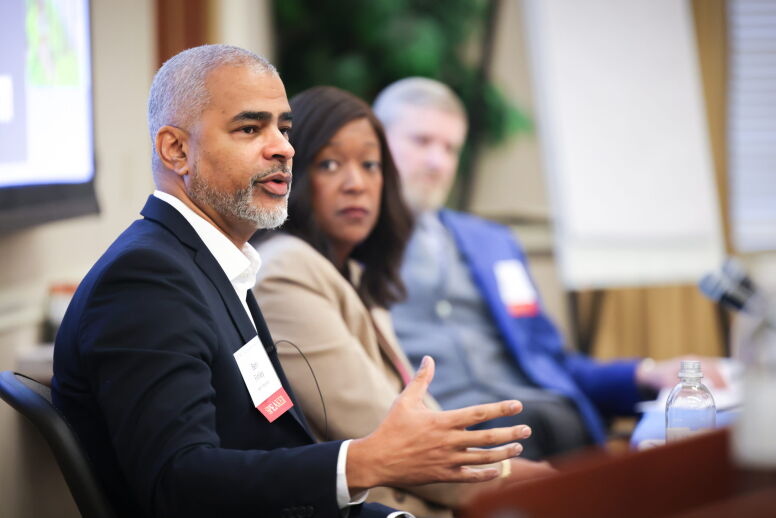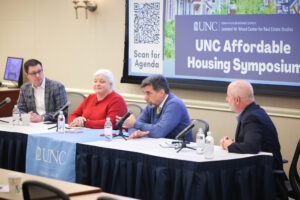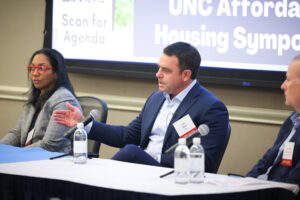Perspectives
Affordable Housing Symposium returns to in-person programming


The Leonard W. Wood Center for Real Estate Studies hosted the UNC Affordable Housing Symposium at the Rizzo Center at the start of the month. Expert real estate, public policy, and finance practitioners were joined by academic professionals to discuss how the United States can combat increased housing costs across the country.
More than 125 people attended the symposium, which returned to in-person programming for the first time since 2019. Over the course of three interactive panel discussions and two fireside chats, industry leaders and academics discussed current housing market dynamics across the nation, explored potential public policy responses and solutions at all levels, examined consequences of today’s rental environment, and investigated the benefits of investing in affordable housing from a capital markets’ perspective.
Opening Keynote: Current Housing Market Dynamics and Potential Policy Responses with Vicki Been
 The symposium kicked off with keynote speaker Vicki Been, the Judge Edward Weinfeld Professor of Law and Director of the Furman Center for Real Estate and Urban Policy at New York University. During the session, Been detailed the current housing market landscape and explored potential policy responses. With special attention to successful West Coast land use reform policies, Been highlighted future strategies which could be enacted nationwide.
The symposium kicked off with keynote speaker Vicki Been, the Judge Edward Weinfeld Professor of Law and Director of the Furman Center for Real Estate and Urban Policy at New York University. During the session, Been detailed the current housing market landscape and explored potential policy responses. With special attention to successful West Coast land use reform policies, Been highlighted future strategies which could be enacted nationwide.
“Obviously we have an affordable housing crisis, and I think of that primarily as a supply crisis,” Been said, early in the session.
Been pointed to many markers of the nationwide supply crisis, including increasing house prices across the US and a large swath of neighborhoods throughout the southeast where rent is unaffordable even to individuals making the median income level for their community. Between long running market trends and the devastating impact of the COVID pandemic, the supply of homes nationally is at a historic low. Been’s proposed solution lies in increasing the supply of affordable single-family homes and multifamily rentals.
“There is really no place in our nation that doesn’t have a serious affordability crisis,” Been explained. “Americans are becoming stuck because of the incredible difficulty of finding a new place to live and moving there.”
With a background in policy and planning, Been noted that these fields will be pivotal in the evolution of today’s market. The federal government’s tools, such as Low-Income Housing Tax Credits (LIHTC), tax deductions, and President Biden’s recent housing supply action plan, address systematic gaps but cannot be the only solution.
“In many ways, states have been absent from this debate in recent years,” Been pointed out, before listing several states that have fought to change this narrative.
California, Oregon, and Washington state have implemented a “dizzying array of reforms” which target land use, regional planning guidelines, and historic discriminatory policies against certain homeowners. These reforms have already been a success across the West Coast, especially due to their iterative nature. Dynamic policies are paramount to a fluid market, something that has allowed these states to create a comprehensive approach to address the most fundamental flaws system wide.
Although these policies have yet to reach the East Coast, New York City is currently considering providing exemptions from environmental impact reviews for projects under 200 units, a change that allowed California developers to increase the supply of accessory dwelling units (ADUs).
Vicki Been wrapped up the first session of the symposium by shedding light on what is essential to implement any policy nationwide: strong leadership, effective communication strategies and thorough research to set measurable expectations.
“These are the ways in which we can push our states to really step up here to help resolve this very critical affordable housing crisis,” she explained.
Exploring Public Policy Challenges/Solutions Panel
 Philip Porter, Senior Vice-President, Head of Acquisitions with Enterprise Community Investments, moderated the three-person panel which included Novogradac’s Housing Policy Consultant Mark Shelburne, Partner at CohnReznick Beth Mullen, and CEO of Up for Growth Mike Kingsella. The panel defined the problem with capital A Affordable housing and analyzed what local- and state-level responses have and have not worked.
Philip Porter, Senior Vice-President, Head of Acquisitions with Enterprise Community Investments, moderated the three-person panel which included Novogradac’s Housing Policy Consultant Mark Shelburne, Partner at CohnReznick Beth Mullen, and CEO of Up for Growth Mike Kingsella. The panel defined the problem with capital A Affordable housing and analyzed what local- and state-level responses have and have not worked.
Kingsella pointed out that far too many Americans cannot afford to live well. He estimates that across the country, we are around 3.8 million homes short of meeting housing needs.
Shelburne said that the number of people forced to live cost overburdened due to housing is a true market failure.
“You hear some folks say let’s get rid of zoning and I’m actually kind of at that point now where I’m done with zoning,” he said. “Even if we did that it’s not going to solve the problem because we had none in America before 1920 and yet the way that the market served low-income households was still through substandard housing.”
Mullen agreed and said there is too much red tape to make affordable housing a reality.
“There has been a long history of needing to fight it out tooth and nail to be able to build anything that’s affordable,” Mullen said. “All of these policies are like ‘we care about folks,’ and all of these things that people say, but they are acting completely contrary to meeting the needs of our lowest income residents.”
How Developers and Owners are Navigating Current Market Conditions Panel
The second panel of the day was moderated by The Franklin Johnston Group President Chris McKee. He was joined by Laurel Street President and CEO Dionne Nelson and April Housing Managing Director and Head of Transactions Group Benjamin Finley.
Nelson said that this market cycle has been one of the most challenging of her development career as she feels like they are always chasing a moving number.
“We have deals that we have had to restructure two and three times,” she said. “We’ve gone back to municipal partners two and three times to try to restructure the subsidy or the affordability restrictions and be creative about how to continue to move it forward.”
Finley said that he is keeping an eye on the math being used when calculating rents, as people try to make up for the three-year lag brought on by the pandemic.
“By the end 0f 2024, we think we will have fully adjusted inside the portfolio from the impacts of the pandemic to pre pandemic levels by absorbing that loss to lease,” he said. “That’s there, but AMIs (Area Median Income) and FMRs (Fair Market Rent) in coming years will show some addition rent growth.”
Capital Markets Panel
 Following lunch, Blackfin Co-Founder Andy Buchanan moderated the third and final panel of the day. Nuveen Senior Portfolio Manager and Wood Center Advisory Board member Pamela West joined JP Morgan’s Head of Community Development Banking and GSE Agency Lending Vincent Toye and CBRE’s Vice-Chairman of Debt and Structured Finance James Flinn. The panel talked about how the commercial real estate industry can provide better opportunities to grow the affordable housing stock and how all aspects of capital markets can be leveraged to do so.
Following lunch, Blackfin Co-Founder Andy Buchanan moderated the third and final panel of the day. Nuveen Senior Portfolio Manager and Wood Center Advisory Board member Pamela West joined JP Morgan’s Head of Community Development Banking and GSE Agency Lending Vincent Toye and CBRE’s Vice-Chairman of Debt and Structured Finance James Flinn. The panel talked about how the commercial real estate industry can provide better opportunities to grow the affordable housing stock and how all aspects of capital markets can be leveraged to do so.
Flinn pointed out that Fannie Mae and Freddie Mac have each been given $75 billion this year to lend with the mandate the 50% of that must be mission driven.
West said Nuveen is no stranger to using Fannie/Freddie loans when acquiring and conserving affordable housing options.
“The market has certainly slowed down a bit, but we haven’t yet changed our underwriting expectations,” she said. “And certainly, because we have the cash on our balance sheet, we are looking at some all-cash transactions until we feel like the market has come back a little bit.”
Toye said the rates of today are all about perspective.
“Folks who were in the business pre-2008, if the rates were where they are today, would be as happy as could be,’ Toye said. “I think things will settle back down some. But expectations that rates are going back to where they were the last 10-12 years? Not going to happen.”
Closing Keynote: Investing in Affordable and Workforce Housing with Darryl Carter
 To close out this year’s Affordable Housing Symposium, Founder and CEO of Avanath Capital Management Daryl Carter was interviewed by Charlie Brindell, the former executive chair of Mill Creek Residential and member of the Wood Center’s Advisory Board.
To close out this year’s Affordable Housing Symposium, Founder and CEO of Avanath Capital Management Daryl Carter was interviewed by Charlie Brindell, the former executive chair of Mill Creek Residential and member of the Wood Center’s Advisory Board.
The fireside chat began with a brief exploration of Carter’s personal background, from his childhood in Detroit to his time on the basketball team for the University of Michigan. Carter explained the impact both had on his early days in banking and eventual experience founding Avanath, which is based in Irvine, CA.
“Another thing that guided me in terms of my professional career was watching my neighborhood deteriorate in the 70’s from lack of investment,” Carter said. “If you invest in underserved communities, you can turn them around, because that’s what is missing.”
Carter explained that with the approach of looking at private capital as a tool for the preservation of affordable housing, his company can also change a community through investment and accessible customer service.
Brindell soon brought the conversation to the topic of Carter’s definition of workforce housing, which prompted Carter to discuss the challenging implications of using descriptors like “workforce” to separate anyone seeking affordable housing.
“The fact is, we need more housing in this country,” Carter said. “We need it at a variety of different levels. Some of these definitions create stigmas that defeat our purposes.”
Carter continued to discuss his company’s efforts to invest holistically in communities that benefit from affordable housing.
“At least three things are challenging these communities,” Carter explained. “Housing, the educational system and healthcare.”
Avanath plays a role in assisting such communities through increasing the availability of recreational activities for youth and providing physical locations to host local educational nonprofits. In one community, Avanath’s investment into a development that was 50% project-based, section 8 housing saw a sharp increase in property value and decline in crime rate.
“You will have long-term growth in a community if you continue to make the investment into it,” Carter said of his company’s utilization of the open-end fund model. By doing so, a private investment manager can continuously raise and invest capital into developments.
When touching on the topic of capitalizing on increasing the density in existing housing developments, Carter echoed opinions heard earlier in the day. Through Avanath, Carter has seen benefit in the growing ability to further utilize already existing and acquired affordable housing. He advised investing in places that might otherwise be overlooked, such as a World War Two-era property Avanath invested in recently. Although faced with a dated electrical system, the property provided benefits not always available in modern developments.
“Overall, we have got to change the stigma between renting and buying in this country. As an industry, we have got to do a better job,” Carter explained, before joking that, “Right now, I think we’re just behind car dealers in terms of credibility.”
For more information on the Wood Center’s Affordable Housing initiative or how to donate, please email realestate@kenan-flagler.unc.edu.